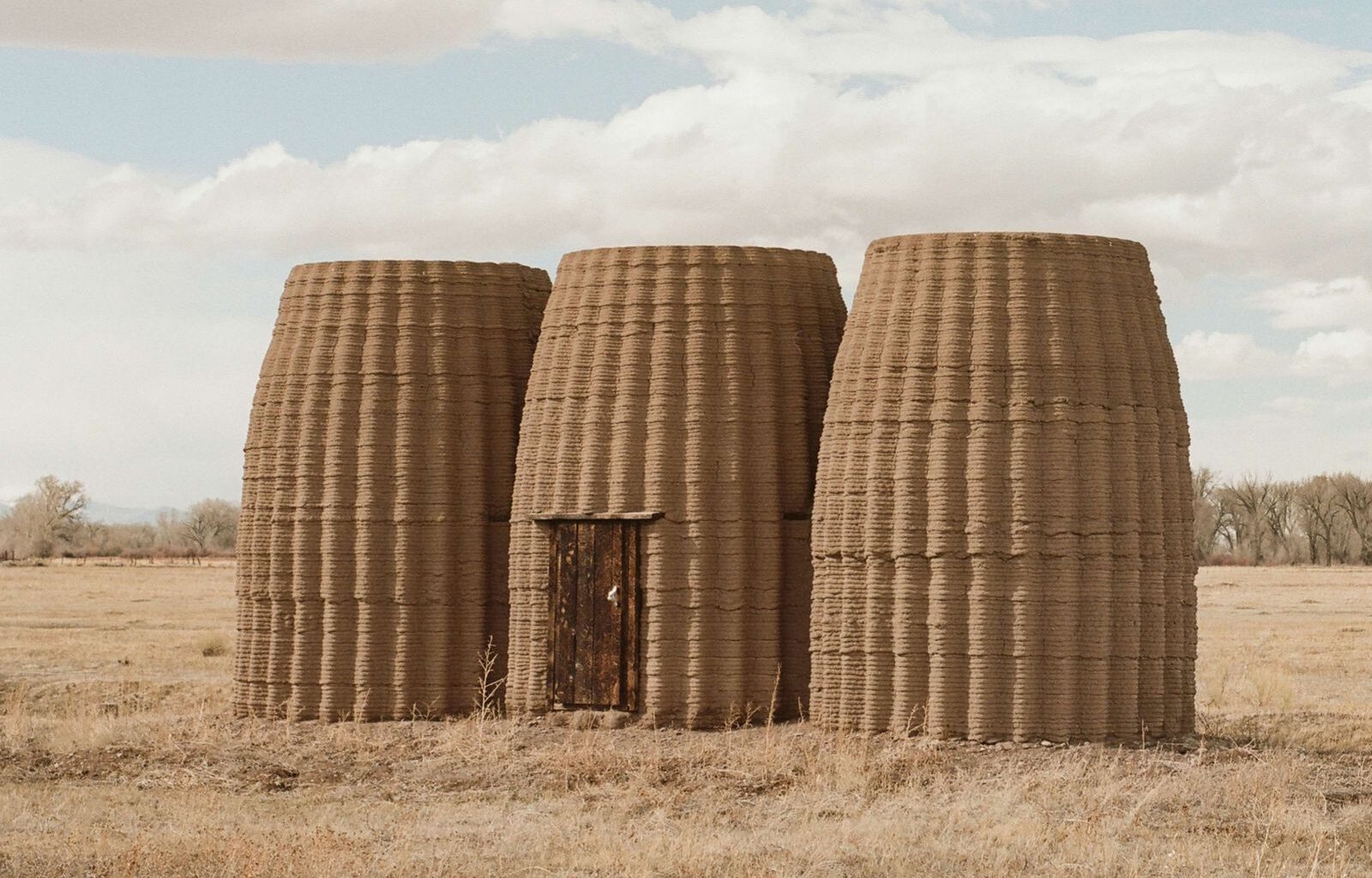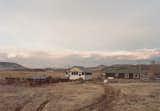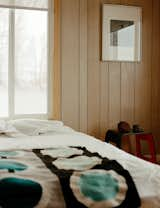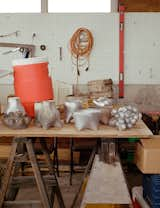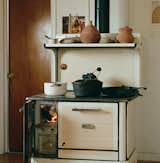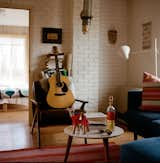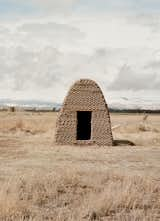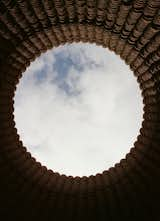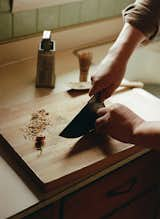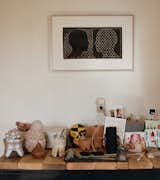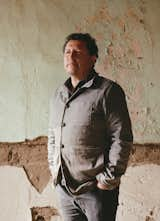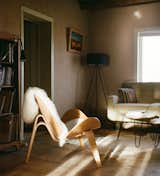Ronald Rael dons a big furry hat while he splits logs into small pieces, tossing them into a wheelbarrow. In every direction, clouds swirl. The skies of Colorado’s San Luis Valley grow increasingly dark and ominous, and it begins to snow. Contrary to popular belief, desert climates—especially high-altitude ones like these—aren’t always scorching hot. Rael hauls his load back to the house, kicks off his boots, and takes an armful of the chopped chunks inside. The open kitchen is a toasty refuge from the inclement weather. Rael, who wields a Swiss Army knife of titles, spanning from designer to professor, author, artist, and entrepreneur, opens the steel hatch on the side of his woodburning stove and stokes the fire.
Using his great-grandfather’s construction as a nexus of sorts and continuing to make adobe buildings and sculptures on the land, Ronald Rael is putting La Florida on a path toward becoming a place for more like-minded thinkers to stay and create. “There will be places for people to make interesting work and interact with the landscape,” explains Rael of one of his many visions for its future.
“This was not a place anyone lived full-time,” Rael explains of the extreme alpine desert where he grew up. “The Utes didn’t live here. The Navajos didn’t live here. This was merely a hunting ground, a seasonal spot.” The territory is characterized as a closed basin, a unique geological formation in which the snowmelt that runs off the southern Rocky Mountains settles directly into the valley below. “There is practically an ocean under us,” Rael says. From bitterly cold winters—so cold that Rael remembers newborn calves weaseling their way into the warm house—to swampy springs replete with biblical plagues of mosquitoes and frogs to the finally idyllic summers, this corner of the earth has made human settlement a particular challenge. Nevertheless, some people, including Rael’s ancestors, eventually made a life here.
His great-grandfather, Miguel Francisco Barela, built an adobe home in the tiny unincorporated village of La Florida. A three-room, pitched-roof construction, which transformed into an L-shaped dwelling with a 1960s addition, housed the patriarch and his family for decades. “I grew up with my great-grandparents, my grandparents, my aunts, and my uncles,” Rael recalls. “Twenty-five members descended here to eat, and they all lived in the little houses out beyond.” Rael looks back with wonder at how his grandmother catered to such a hungry clan mostly from an earth oven outside the house. “She fed the whole town,” he smiles.
Surrounded by windows on three sides, a bedroom with wood-paneled walls retains vestiges of its sixties past and remains a work in progress. While debating the long-term layout of his now abode, Rael has made homey additions to his quarters, like a painted canvas in adobe by his partner, the artist Joanna Keane Lopez, found rocks, and one of three prints from Icy & Sot, the multidisciplinary art practice of Iranian-born, Brooklyn-based brothers Saman and Sasan Oskouei.
In collaboration with Anderson Ranch Arts Center, Rael worked with cast aluminum and bronze to form objects based on his 3D-printed models. The garage-turned-workshop adjacent to his home, which houses power tools and practical elements of life on the farm, has also been a factory of experimentation.
In this patch of land a few miles east of the railroad town of Antonito, Rael’s kin are everywhere. His mom lives in a ranch house across the street, and his brother is just down the road. They seemingly know the whole of Conejos County, and the community knows them right back. The family foothold may have dwindled slightly over the years, but traditions—farming, constructing and maintaining adobes, cattle ranching, managing the people-operated irrigation channels called acequias—run deep. Tending to the land is in Rael’s blood.
“My dad was a carpenter,” he says, though he is quick to qualify the term. “Carpenter” really meant the guy who townsfolk called to build anything and fix everything, whether roofs or adobe walls. Rael was raised in his father’s shadow, assisting on projects around the valley from a young age. When his grandmother passed away in 1994, her historic residence was sold outside the family, despite loud protests from many of its members. Since then, in one way or another—including a failed attempt to secure a ten-thousand-dollar loan as a teenager—Rael has been striving to get it back.
Higher education was not a foregone conclusion for the young apprentice. He was needed at home on the ranch. Yet, at the urging of a school counselor who saw his standardized test scores, he found his way to the University of Colorado in Boulder. Under the impression that the college system existed to produce engineers or doctors, he started as a pre-med student but quickly shifted gears. Rael earned a degree in environmental design before going on to study architecture at Columbia University in New York. The master’s program proved formative but was equally defined by what it was not. “I learned the dogmas of that world,” he says. “It was very narrow.” An abstract design exercise in his first class received a staunch critique from the professor: Rael’s walls were too thick. “Buildings simply do not have walls like that,” he was told. But the mud-brick architectural language of his youth said otherwise. Rael dove head first into the university’s library. “I discovered that the modernists who we were studying upstairs and who used concrete, glass, and steel had at one time worked in adobe,” he says. Between millennia of traditional earth building and modernism, he found a threshold moment for architecture and became completely enraptured.
Rael then fell into academia himself—but completely “by accident,” he laughs. On a visit to his Colorado alma mater, curiosity led him to knock on doors. “How do you become a professor?” he remembers asking. Before long, he was showing his portfolio, and the university hired him to start the following week. He wound his way through various institutions including Clemson University and Rotterdam’s Office for Metropolitan Architecture before landing at the University of California, Berkeley, where he rose to the Eva Li Memorial Chair in Architecture.
A true family heirloom, the heritage stove continues to warm the home and produce meals as it has for decades. On its ledge, Rael displays grinding stones, 3D-printed clay vessels, and cast-aluminum bricks. He is known around the valley for converting thousands of used cans into the latter. Neighbors have taken to sending their used soda and beer containers his way, curious to see how they will eventually transform into sculptures and other functional pieces.
Rael balances a heavy workload with quiet moments of unwind curled up in the living room, fiddling on the acoustic guitar, testing spirits like Bacanora or Sotol toted back from Mexico by a friend, or crafting a string of puns with his son, Mattias.
He began a free-form practice steeped in the notion of challenging the boundaries of architecture and objects. Take the provocative piece Teeter-Totter Wall, which transformed the slats of the United States–Mexico border wall into bright-pink, temporary seesaws. The installation, which briefly brought individuals together to remind viewers that “the actions that take place on one side have a direct consequence on the other,” earned the project and its team members awards and recognition, further cementing Rael’s beliefs in design as cultural expression.
In the meantime, Rael was becoming the face of 3D printing in mud. Images and videos of his large-scale, robotically made adobe structures are now inextricably linked with his name. He has been featured in publications such as Wired, the New York Times, and Domus, and his work has been exhibited at the Museum of Modern Art, London’s Design Museum, and the Cooper Hewitt, among others. He has penned multiple noteworthy books, including Earth Architecture, a study of the oldest building material in the context of today’s world, and Borderwall as Architecture, a potent examination of the physical barrier separating the United States and Mexico.
With nearly all he touches, Rael is a practitioner of the “remix.” From the kitchen, where he puts a spin on tried-and-true recipes like atole, a porridge-like beverage made from corn, to his art and architecture, Rael blends ancestral knowledge and materials with personal overtones and frontier techniques. In 1996, when the internet was dawning, Rael’s brother started a website to showcase the young architect’s restoration work on a historic building in La Florida. The dialogue that spawned from that rudimentary page catalyzed Rael to engage with online forums. There, he stumbled upon the work of Iran-born Behrokh Khoshnevis, a mechanical engineering professor at the University of Southern California. Khoshnevis had been developing a technology to produce large-scale, 3D-printed concrete objects. While he was perfecting with concrete, he experimented with mud. “That’s the future,” Rael realized upon seeing the test runs.
On any given day in La Florida, Rael flows between a diverse set of heavy machines without skipping a beat. With equal mastery, he commands his family’s tractor—fitted with a front-end loader to dig trenches and build dams—and his enormous, high-tech 3D printer with its mechanical arm.
From the initial spark, a slow-burning fire lit inside him. After struggling with a self-made machine, Rael came across an engineer in Florida who was developing a ceramic 3D printer. “I contacted him and bought one of his very first printers. Then, I started making these weird things in clay,” Rael recalls of his early days in the medium. “The ceramics world was like, ‘Whoa!’” He went on to cofound Emerging Objects, an innovative 3D-printing brand that employs other varied materials like salt and rubber. But Rael felt a growing urge to print bigger. He imagined a robot capable of producing an entire building with earth, converted his vision into a video, and sent it off to the Florida engineer. The partnership paid off, and in 2019, Rael hit the ground running.
For the mud master, thinking about earth building is inherently connected to the San Luis Valley. After continuously asking the owners of his erstwhile family compound to sell, they finally relented. Then in 2020, when society was forced to slow down and in-person teaching was put on hold, he truly committed to his return. “I have never said that I live in California,” he explains. “I work in California, and I live here.” Though he values his West Coast existence, this tug of his homeland is constant. “This was my dream for the last twenty years,” Rael says. “Being back in this house, I’m actually living it.”
On Father’s Day of 2022, Rael and Mattias—whose birthday happens to be just one day apart from Rael’s—restored the primary home’s outer layer to its original state by removing concrete and applying a mud plaster. From a young age, Mattias has worked alongside Rael building hornos, or earth ovens, collaborating on larger 3D-printed buildings, and even driving the tractor.
Reintegrating has been an ongoing effort for Rael. When he arrived, much of the property had fallen into disrepair or was simply outdated. Rael replaced old linoleum and carpet with Douglas fir from a local mill. He and his son, Mattias, removed concrete plaster applied in the 1960s to return the adobe facade to its natural state. Small window openings were expanded to allow more light to permeate, and Rael is currently redesigning the roof of the addition to match the pitch of the original home.
His grandmother’s stove, which now serves as the hearth and emotional center, had left with the 1994 sale and roamed with an aunt. “She moved five times and hauled that giant thing around,” he says, “but when I moved in, she insisted that it needed to come home, too.” Elsewhere, he decorates with gifts from students—like a maté cup fashioned from a hoof, grinding stones that he and his mother find on walks, his own 3D-printed vessels and cast-aluminum objects, a miniature teeter-totter wall made from a joined dollar bill and Mexican peso, and ceramics from Johnny Ortiz-Concha. Walls are adorned with pieces from Icy & Sot that Rael traded his own work for, a framed woven specimen from the embroiderer Marcella Pacheco in the valley, and a poster from a gallery opening for West Texas legend Boyd Elder. In everything, Rael is writing a new chapter for the home and surrounding land, infusing his own identity while cherishing the outside influences that enrich it.
The Nubian vaults championed by legendary earth-building architect Hassan Fathy became a fertile source of inspiration for Rael in the ’90s. He sought out one of the Egyptian’s students and foremost stateside practitioners, Simone Swan, who was constructing a home with a team of volunteers on the border of West Texas and Mexico. From those practical seeds, the road to Terrano—the world’s first ever construction with a roof 3D printed in situ—was paved. “Building upon the genius of the past,” Rael once wrote, “is one small step towards a larger goal of producing architectural elegance using humankind’s most humble material.”
Each of the three massive adobe volumes that Rael printed on his property in 2020 open to the sky and, with no foundation, connect directly to the earth. Titled Casa Covida, the project combined new approaches with ancient, Indigenous traditions to reimagine cohabitation and connection in the midst of a global pandemic.
With the dwelling and a growing cache of historic buildings, Rael is at once safeguarding heritage, strengthening collective identity, and manifesting the future that he envisions. One of his structures, part of his self-designated “Adobe Archipelago,” is a former Indian Agency that served as an outpost for the Native American slave trade and bears the scars of a region still coming to terms with its recent past. Across the border into New Mexico, Rael is striving to save an 1800s adobe village, which still hosts the private Catholic brotherhood Los Penitentes. He is a preservationist and, simultaneously, a futurist and inventor.
Without building codes, Rael and his collaborators can utilize the land of La Florida as a laboratory. On a parcel adjacent to his mother’s house, Rael and a dedicated team dreamed up Casa Covida, a triptych case study of circular rooms for the purposes of sleep, bathing, and gathering around the fire. In another corner, various studies in mud from Rael and his students test the limits of 3D-printed adobe. The masterpiece, though, is the first-ever structure with a roof printed on-site. Though Rael has yet to assign a specific purpose to the building named Terrano, it serves as a powerful representation of a rapidly approaching reality. Using a newer robot given to Rael by a philanthropic entity, his limits continue to expand. “I used to be stuck on circular designs in order to print the biggest thing possible,” he says. “I was literally and metaphorically reaching as far as I could.” Terrano is also his first foray into vaulted architecture inspired by the likes of the Egyptian architect Hassan Fathy.
As he settles back into the San Luis Valley, Rael embraces the food of his youth. Dried hominy has been soaking in the kitchen since morning. Wielding a massive, hand-forged vegetable knife, he chops dried chiles to add some heat to a pot of pozole, an aromatic soup highlighted by pork and robust corn kernels.
Cherished objects—clay spoons from the New Mexico ceramicist Brandon Adriano Ortiz, greeting cards from loved ones, 3D-printed atole bowls, carved gourds, and an Incienso de Santa Fe incense holder—sit atop a flat-file cabinet and in front of an Icy & Sot work.
“I feel like I grew up in the 1800s, when electricity and running water were brand-new,” Rael says of his rural upbringing. “And now I work with robots in the very same place.” Through it all, Rael endeavors to make connections across the many borders within him. From vernacular architectural methods blending with futuristic construction to a complex personal identity that encompasses Indigenous and Mexican roots and an upbringing in the United States, returning to the land of his ancestors has allowed Rael to celebrate the many layered realities. “I no longer have to think about impressing all of those people who I was told to impress,” he says. “It’s actually about impressing my mom and my community and being respectful of this landscape and its history.”
Rael has developed something of a reputation in the greater community for collecting old adobe buildings, with locals occasionally calling him up to gauge his interest in a new acquisition. Every structure, like the shell that is the former Gomez and Sons cabinetry store in downtown Conejos, brings him closer to understanding his roots in this former borderlands between the United States and Mexico. “After the Mexican-American War,” Rael says, referencing the conflict whose 1848 culmination saw Mexico cede large swaths of the present-day western United States, “a bunch of people decided to stay” and become U.S. citizens, creating a complex web of cultures.
Rael hosts guests and students in the Dominguez House, a neighboring dwelling that belonged to his great-aunt’s family and exists within the network of structures that he has dubbed the Adobe Archipelago. In the space, now an extension of his own home, he decorates with the likes of a Hans Wegner–inspired Shell chair covered in shearling and plentiful books and records.
The wood in the stove crackles and pops as Rael brews a tea. Oshá, a medicinal root akin to wild celery and endemic to the lands of Southern Colorado and Northern New Mexico, simmers in the pot. Rael adds rose hips and local honey—another remix—to his concoction and sips gently from his cup. “This stuff is better than aspirin,” he quips. His mother, Christina, knocks on the kitchen door, popping in to deliver the mail. Rael revels in the fact that his world—from his family to his students, fellow artists, architects, professors, and fans—has started coming to him. “It really feels like there is a positive exchange happening,” he reflects. From his multigenerational abode to the testing grounds of La Florida, from Conejos County to New Mexico and the borderlands, Rael has found his purpose. It’s a remixed nation of his own making. “This,” he says, contemplating the gravity of all that this entails, “will be what I’m working on until the day that I die.”
Buy the book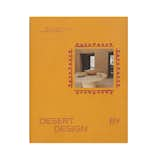 Desert by Design
Desert by Design
Desert by Design celebrates the interior worlds that exist in Earth’s most arid climes and, more importantly, the creative minds who inhabit them. Marfa, Texas-based desert dwellers Molly Mandell and James Burke traveled the world to explore and photograph thirty incredible spaces.
Excerpted from Desert by Design by James Burke and Molly Mandell, published by Abrams Books. Text and photographs copyright © 2025. All rights reserved.
We love the products we feature and hope you do, too. If you buy something through a link on the site, we may earn an affiliate commission.
More from Ronald Rael:
